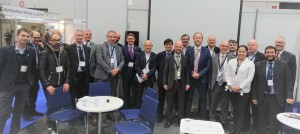May 2019
Second step taken towards European technological independence regarding large deployable reflectors
HPS-consortium wins ESA´s LEOB challenge
The European consortium of 17 partners out of six European countries initiated and led by HPS GmbH has won the prestigious ESA contract for LEOB, the Large European Reflector for Earth Observation. The call had been initiated by ESA´s Earth Observation directorate in 2018.
The HPS consortium, including LSS Germany and RUAG Space Germany, won against severe competition from Italy, Spain, and the U.K.. Total budget amounts to 5 million €; taken together with contract number one on the development of a large deployable reflector out of late 2017, the budget to develop this critical technology now amounts to 12.5 million €. Future mission targets include geological changes, monitoring of vegetation, communications, Big Data, Internet of Things, and sciences.
Kick-off was on April 15th, 2019, the project will conclude with a tested Engineering Model exactly two years later in April 2021. It is the last precursor project before the development of a flight model for two future Copernicus missions: CIMR with a 7-8m reflector, operating in L- through Ka-band, rotating on top of the satellite at a speed of ten turns per minute, and ROSE-L with 12 meters of diameter, operating in L-band.
Precursing ESA-technology programs and LEA out of Horizon 2020 had laid the foundations for this great success.
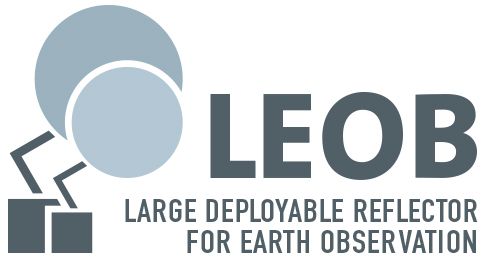
Freitag
June 2019
Aus dem Tagebuch des Bundestagsabgeordneten Dr. Thomas Sattelberger (FDP)
Flug nach München. Gemeinsamer Termin mit meinem Parteifreund Wolfgang Heubisch MdL, Bayerischer Wissenschaftsminister a.D., heute Landtagsvizepräsident und forschungspolitischer Sprecher der FDP im Bayerischen Landtag.
Mit dabei Maria Herrmann, Büroleiterin meines Berliner Fraktionskollegen Mario Brandenburg. Wir besuchen Raumfahrtmacherinnen und -macher im Münchner Süden, die HPS GmbH. Für mich bereits der zweite Besuch.
Am 20. Juli vor 50 Jahren wurde John F. Kennedys Vision „We choose to go to the Moon” Wirklichkeit.
Dazu planen wir was. Was? Sage ich nicht. Könnte ja auch sein, dass wir ob der Berliner Arbeitslast vorher in die Knie gehen.
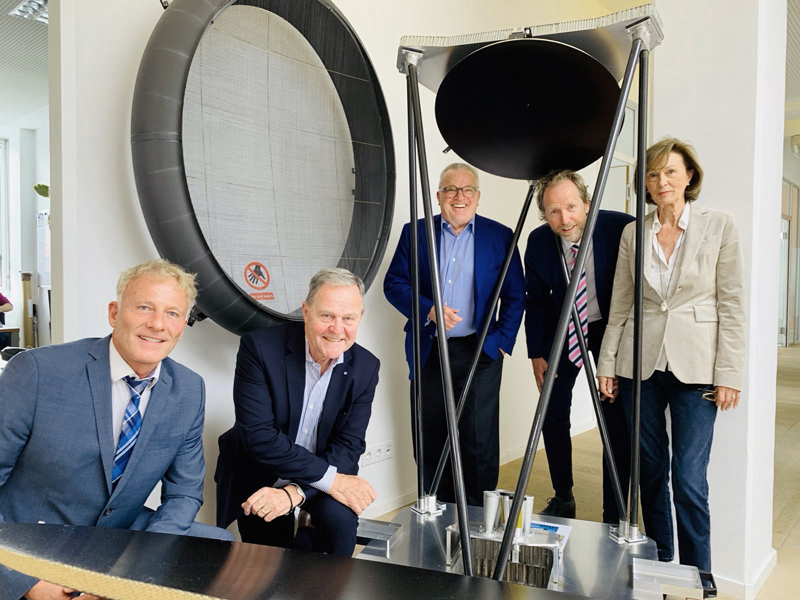
Pressemitteilung
July 2019
Geschäftsführender Gesellschafter von HPS, Ernst K. Pfeiffer, Mitveranstalter von „What`s next in space“ im bayrischen Landtag
Inhalt der Veranstaltung war die Diskussion eines neuen Kurses für die deutsche Raumfahrt mit abschließender Präsentation von 7 Forderungen an die bayrische Landesregierung und die Bundesregierung.
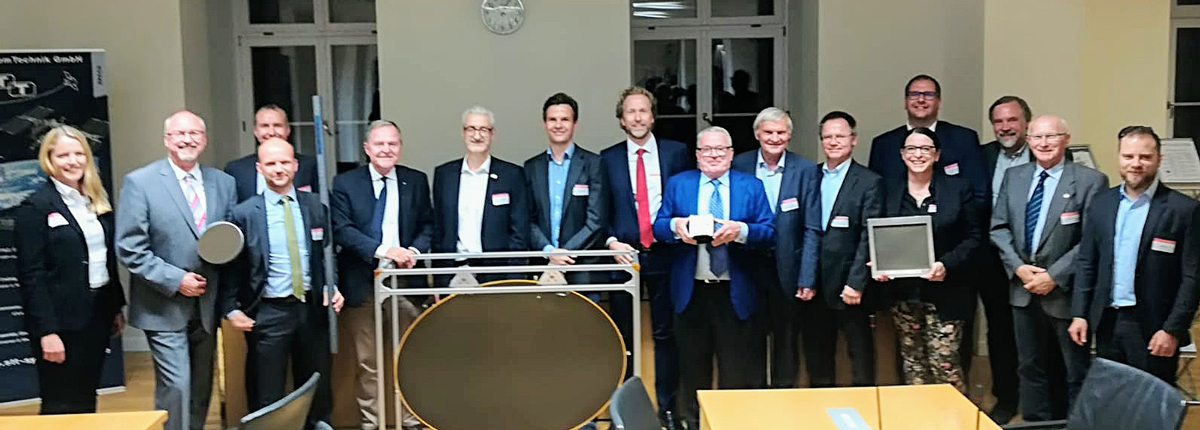
50 Jahre nach der Mondlandung: Wie sind Deutschland und Bayern aufgestellt bei der Zukunftstechnologie Raumfahrt? Wo liegen die größten Chancen? Wo besteht Handlungsbedarf? Wo muss die Politik mit Hand anlegen und unterstützen?
Veranstalter:
- h. c. Thomas Sattelberger MdB, Sprecher für Innovation, Bildung und Forschung der FDP-Bundestagsfraktion, Wahlkreis München-Süd
- Wolfgang Heubisch MdL, Vizepräsident des Bayrischen Landtags, Bayrischer Staatsminister a.D. für Wissenschaft, Forschung und Kunst
- Dr. Ernst Messerschmid, deutscher Physiker und Astronaut (1985)
- Ing. Ernst K. Pfeiffer, Vorsitzender des Verbands mittelständischer Raumfahrtunternehmen „Best of Space“
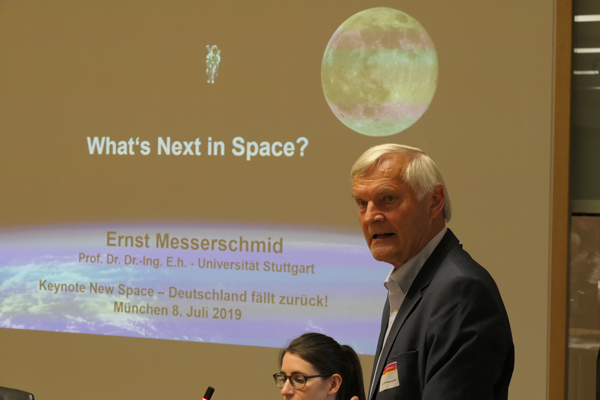
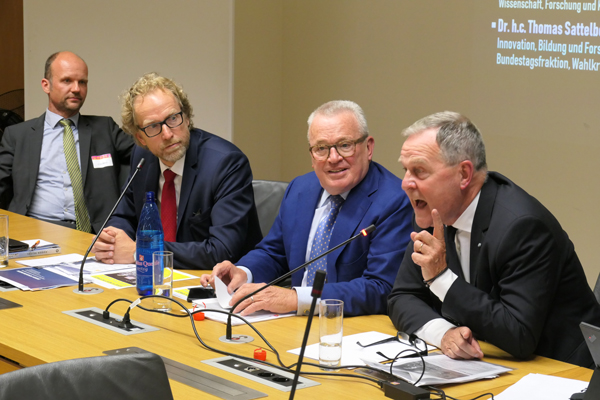
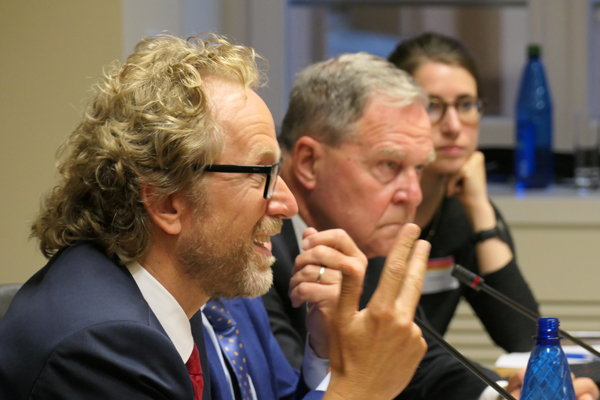
Aufbruch in die Vergangenheit
July 2019
Das deutsche Röntgenteleskop, entwickelt vom MPE (Max-Planck-Institut für extraterrestrische Physik) in Garching, „eROSITA“ ist zusammen mit einem russischen Instrument am 13. Juli 2019 um 14:31 Uhr mitteleuropäischer Sommerzeit (17:31 Uhr Ortszeit) erfolgreich vom Raketenbahnhof in Baikonur gestartet.
Zurzeit befindet es sich auf dem Weg zum 2ten „Lagrange Punkt“ (L2), 1.5 Millionen Kilometer von der Erde entfernt.
Am L2 angekommen wird eROSITA alle sechs Monate den gesamten Himmel abtasten und so eine exakte Karte vom Universum im Röntgenbereich erstellen. Die Daten werden genutzt um die „Hotspots“ des Universums zu kartieren; Supernovas, Neutronensterne und schwarze Löcher stehen ganz oben auf der Liste.
eRosita kann überdies von den Bewegungen der Galaxien, Rückschlüsse auf die Dunkle Energie schließen. Jene unbekannte „dunkle“ Kraft, die das Universum expandieren lässt.
Alle elektromagnetischen Wellen, wobei die Röntgenstrahlung ein Teil davon ist, breiten sich mit Lichtgeschwindigkeit aus. Das Licht ist schon Millionen oder sogar Milliarden Jahre unterwegs wenn es die Detektoren von eRosita einfangen. Darum ist der Blick in den Himmel auch immer ein Blick in die Vergangenheit.
HPS hat von 2010 bis 2016 das MPE bezüglich Thermal Schutz-Design durch MLI (Multi-Layer-Insulation) für eROSITA begleitet. Auslegung, Fertigung und Integration wurden für zwei Modelle QM (Qualifikations-Model) und PFM (Proto-Flight-Model) durchgeführt.
Es befindet sich insgesamt 14 kg High-Tech-Folien Material (MLI) auf dem Teleskop. Ausgebreitet würden die Folien eine Fläche von über 500m² ergeben, was in etwa einem Basketballfeld entspricht.
Nach der langen und äußerst guten Zusammenarbeit freut sich das HPS Team mit dem MPE sehr über den geglückten Start des eROSITA Röntgen-Teleskopes.
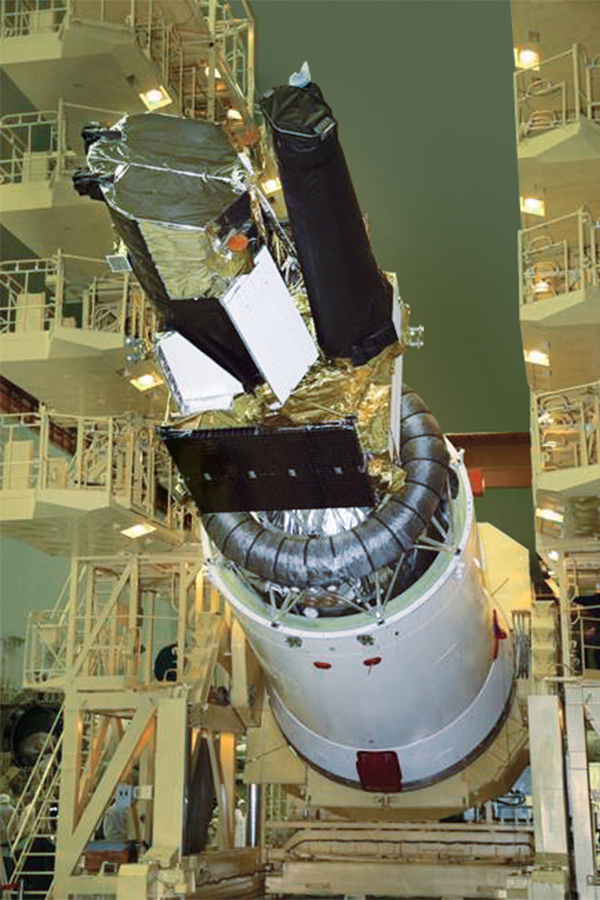
Europe´s Euclid-Mission Taking a Giant Leap Forward
September 2019
HPS hands over Euclid´s Flight Model of Antenna Reflector Assembly (ARA) to TAS-I in Rome
Euclid, ESA´s ambitious mission to map geometry and development of the Dark Universe over the past 10 billion years from 2022 on has taken a big step forward: HPS delivered the ARA-flight model hardware to ESA´s prime TAS in Rome and the communication subsystem prime TAS in Madrid after all tests (TVT, Bake-out, modal survey, optical check and main reflector contour, grounding and MLI/SLI installation) had been concluded successfully and on time.
Euclid´s ARA (Antenna Reflector Assembly) is one of the mission´s hardware keys, since it is responsible for transmitting all the scientific data, which will provide an unprecedented insight into the origin of the Universe. Extremely lightweight and stable materials have been employed in the just 4.5 kg reflector assembly to assure the demanding strength and performance requirements from the launch phase until the operations at the second Lagrangian point L2, located at 1.5 million kilometers from Earth. The high end precision in the micrometer range has been achieved in the single parts positioning during the alignment activities, allowing optimal performances in the signal transmission.
The Consortium, led by HPS GmbH (Munich based German SME) has successfully implemented the involvement of several countries across Europe. HPS would like to thank its partners for the outstanding work performed together: Invent GmbH in Germany for composite technology, SERENUM a.s. in Czech Republic for metal parts, AAC GmbH for environmental testing, FHP Ltd. in Portugal for Multi Layer Insulation technology and ONERA in France for radio-frequency characterisation testing.
Already back in 2017, HPS had successfully delivered a first Structural-Thermal Model (STM) of the Euclid ARA as well as an Engineering Qualification Model (EQM) in 2018 for testing and qualification purposes at satellite level. The delivery of the Flight Model now took place end of August 2019.
The customer chain explicitly “appreciates the effort done by HPS to fulfill the schedule dates in this complex period of the summer break and congratulates to all the good results obtained”.
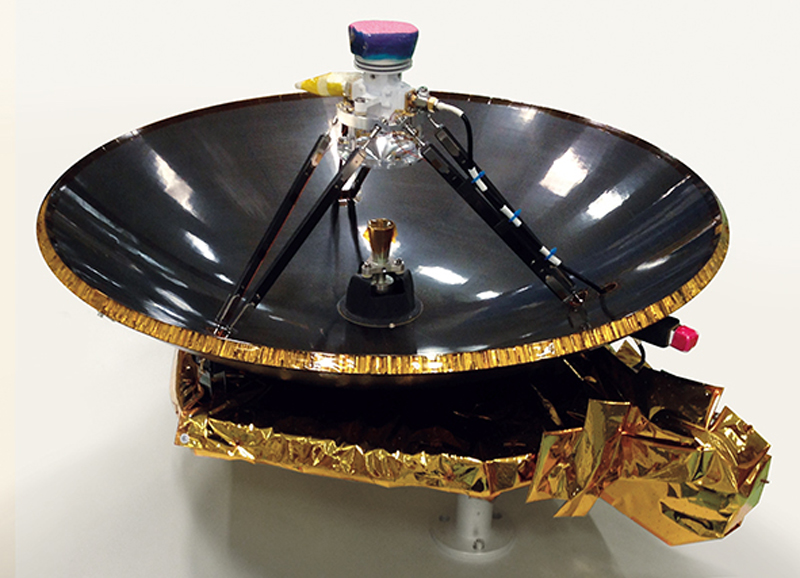
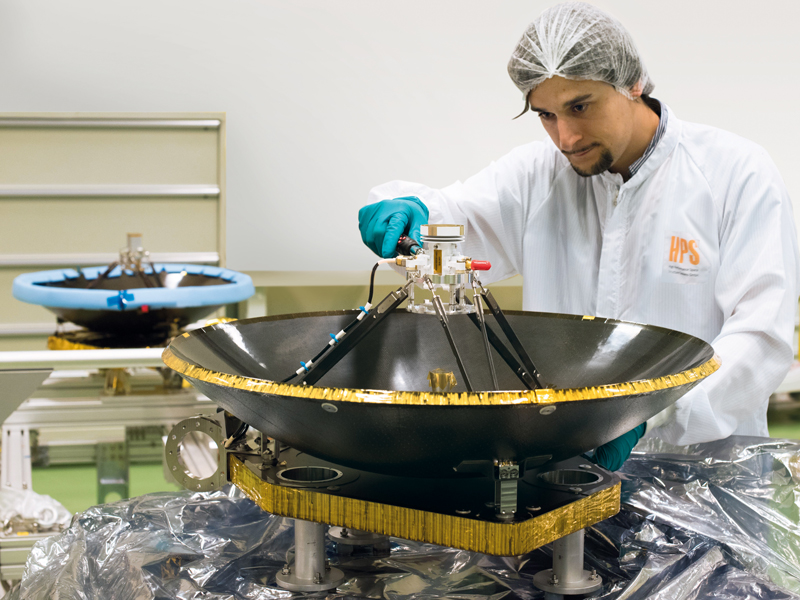
Large European Antenna – LEA
October 2019
A European Declaration of Non-dependence in Space
Dear Friends and Fans of Europe in Space,
in the name of all members of our pan-European WeLEA-consortium we proudly present a video, documenting the successful road of the development of one of the most needed critical technologies in space: the Deployable Large European Antenna (LEA).
Invented, designed, tested and manufactured by more than 15 well known space companies from 7 European countries with a total staff of more than 500 dedicated specialists, representing a truly unique team of SMEs and Midcaps, the LEA-product is now taking shape as nothing less than “A European Declaration of Non-dependence in Space”.
Thanks to the farsighted vision of both powerful institutions responsible for our continent´s future in space, the European Space Agency ESA and the European Commission EC, LEA will become an invaluable technological asset to blaze our own trail towards knowledge and understanding as indispensable prerequisites to making this world a sustainable, better place – for life in diversity, for all citizens on the globe, and for one Europe across all its internal borders.
Within the WeLEA consortium HPS Germany, as prime contractor, is responsible for the project- and technical management of the whole LEA-subsystem, the deployable arm assembly and the reflective metal mesh.
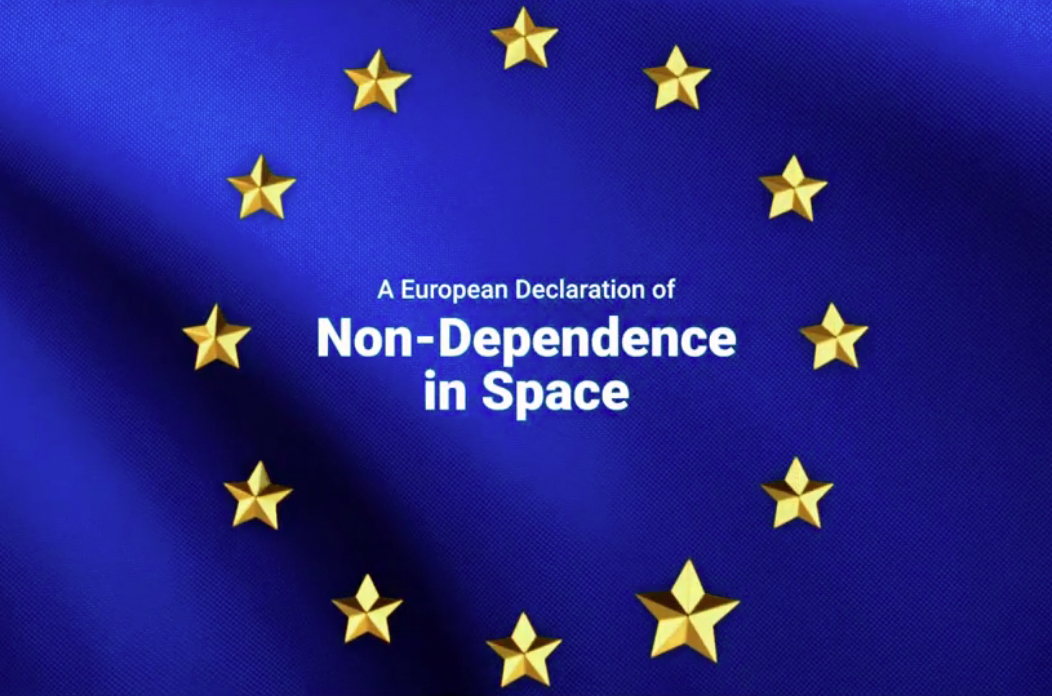
KMU-Verbund im AKRK setzt auf Kontinuität
November 2019
Nach einem für die deutschen Raumfahrt-KMU erfolgreichen Jahr setzt ihr Verbund im Arbeitskreis Raumfahrt des DLR (AKRK) auf Kontinuität und bestätigt ihren Sprecher, Dr. Ernst K. Pfeiffer sowie den stellvertretenden Sprecher Dr. Kolja Nicklaus für eine weitere Wahlperiode im Amt. Hinzu kommt als zweiter stellvertretender Sprecher Herr Maik Hartmann von Astro und Feinwerktechnik.
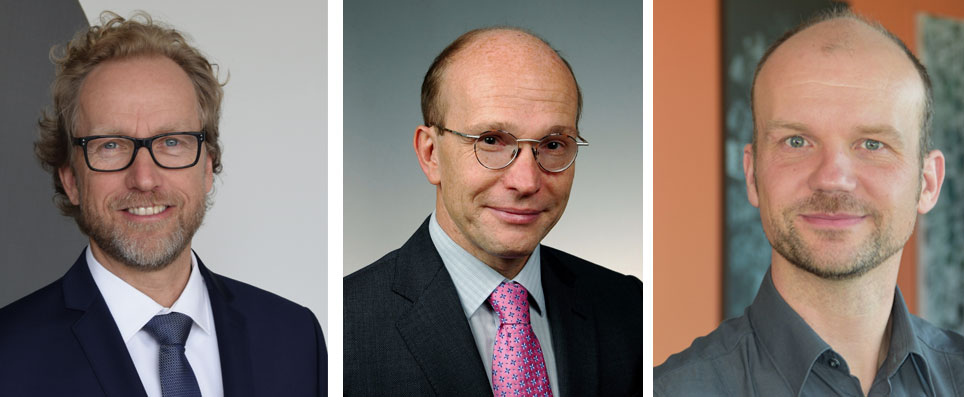
Best of Space erfolgreich auf weltgrößter Raumfahrtmesse
November 2019
KMU eine feste Größe auf Bremens SpaceTech Expo Europe
Sie ist drei Tage kurz, hat ihre Heimat im kleinsten Bundesland der Republik, benötigt nur rund zwei Hektar Ausstellungshallen, und doch ist die SpaceTech Expo Europe die größte, nämlich größte Raumfahrtmesse der Welt.
Erst zum zweiten Mal fand sie nach der Premiere 2017 statt, seither ist sie vom Start weg schon um 30 Prozent gewachsen und damit schon mehr als zehnfach größer als der Raumfahrtteil der ILA: 400 Aussteller und mehrere Zehntausend Besucher, zumeist vom Fach und mit konkreten Geschäftsabsichten aus Europa, den USA, Indien, China, Japan und Südamerika sowie Australien machten 2019 diese Messe zum globalen Hotspot der Raumfahrt.
Und in ihrer Mitte ruht der Kern – sowohl bildlich wie auch inhaltlich. Denn die Szene wurde klar dominiert von den etablierten KMU und den hoffnungsvollen NewSpace Startups, flankiert von allen wichtigen Midcaps und LSI. Die Best of Space – Unternehmen nahmen ihren zentralen Platz neben SME4Space und der ESA, unweit von DLR und den Großunternehmen ein. Der Stand war Anlaufpunkt und Diskussionsforum für alle AKRK-Mitglieder, er wurde lebhaft von ihnen für Gespräche mit institutionellen und kommerziellen Kunden genutzt.
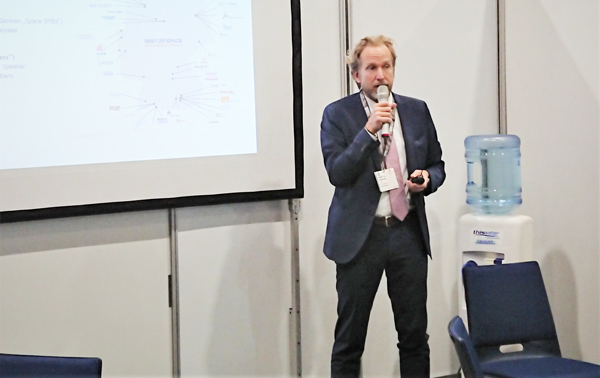
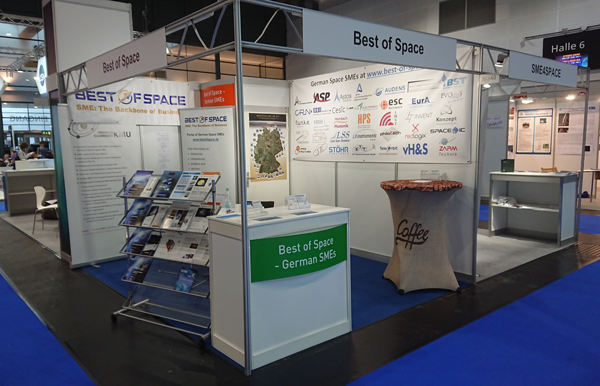
Einige Zahlen mögen dies einmal auf etwas ungewöhnliche Weise untermauern: 1,75 Kilo Mars, Twix und Gummibärchen, 4 Säcke Äpfel, Bananen und Mandarinen sowie 24 Liter alkoholfreie Getränke wurden in den drei Tagen allein hier „vernichtet“. Der Dank des Ausschusses für die wieder einmal reibungslose Organisation geht auch 2019 an Jens Janke, CRN Management GmbH, und für die finanzielle Absicherung der BoS-Präsenz an die AKRK-Unternehmen.
MESH Made in Germany
March 2020
Technical Textiles from Bavaria for the Worldmarket Space
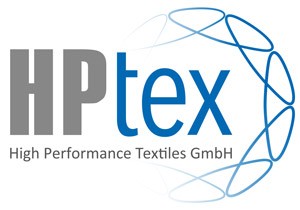
With the foundation of HPTEX GmbH in equal shares by the Bavarian companies HPS GmbH and Iprotex GmbH & Co KG, a company is being launched that no one else in the space industry has ever had on the cards before: HPS, the European specialist for satellite antennas of all sizes, and Iprotex, the heavyweight for technical textiles on the world market, are joining forces and competences to establish Bavaria and Germany as the centre for metallic high-tech fabrics, the “mesh”, in ordere to serve the international space market.
The HPTEX GmbH joint venture thus aims at a key component of satellite technology for two core applications at the same time: Earth observation and communication.
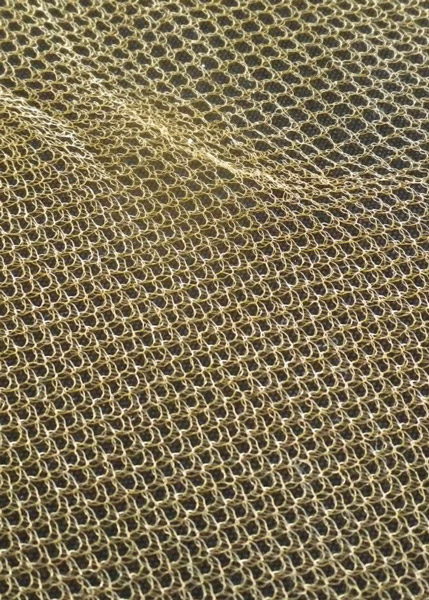
For both, the mesh functions as a resonance body for reception and transmission of radar and communication data between heaven and earth, for generating images for climate protection and to provide stable communications networks for the earth’s population. The precision of production is measured in micrometers, i.e. ten thousandths of a centimeter, and must achieve an optimum between electrical conductivity and mechanical elasticity homogeneously over reflectors of up to 15m diameter, for frequency bands between L- and Ka-band, and in the medium term also up to V-band. To guarantee this, the two companies behind HPTEX have concentrated development and production technology of the latest generation at the Münchberg site in order to meet the extremely special requirements of the customers.
Initial mission objectives are the pre-development and pre-qualification of a Ka-band mesh for “CIMR”, a satellite of the EU Commission’s latest flagship fleet Copernicus for the observation and measurement of climatically relevant developments in the Arctic, and a series of small satellite antennas from the commercial NewSpace sector. In the area of research and development, HPTEX works closely with the leading institutions in the region, the Fraunhofer Münchberg and the University of Hof.
For a transitional period of a few weeks, direct sales of the products will continue to be handled by HPS in Munich until the new staffing levels have been established to allow HPTEX to take over.
Flight model of the H2NBA Feed Assembly successfully completes RF test
March 2020
The „Feed Assembly” as an essential component in the RF signal transmit/receive-chain of the Ka-band North Beam Antenna “H2NBA” for the Heinrich Hertz Mission was successfully assembled in February 2020.
Before the time consuming final surface treatment the assembly was RF-tested in the test laboratory of ADS, Munich Ottobrunn.
Other components of the H2NBA-Antenna such as the “CFRP Reflector Assembly” as well as the mechanisms for antenna deployment and pointing and the fixation during launch are already nearing completion. The final integration and all tests at antenna level will take place according to schedule between July and October 2020.
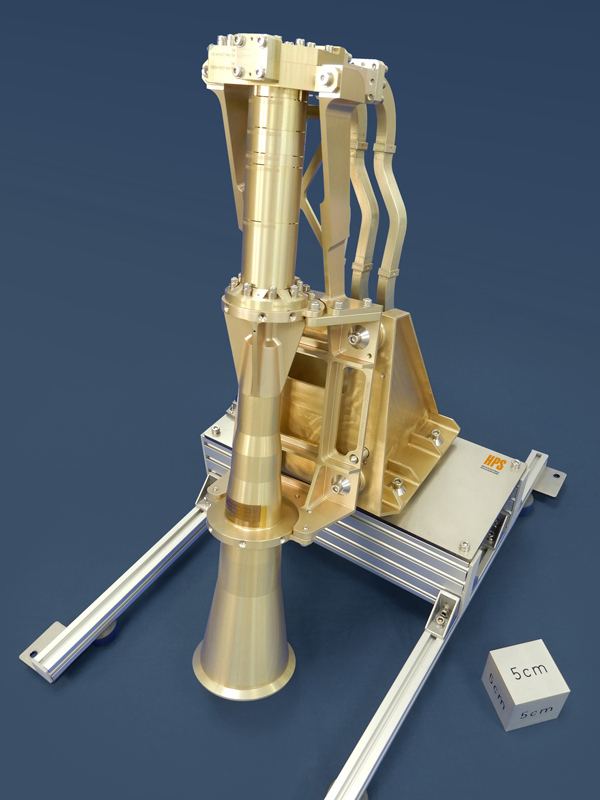
Next centrepiece of German telecommunications technology successfully tested
October 2020
HPS antenna for space mission Heinrich Hertz passes meticulous test
With the launch of the Heinrich Hertz satellite in 2023, Germany will once again be flying the black-red-golden flag in satellite telecommunications – twenty years after the DFS Kopernikus mission completed in 2002 – on the innovative “Small Geo” platform from OHB 36,000 kilometers above the earth. On board Heinrich Hertz are some 20 experiments on communications, antenna and satellite technology being conducted by institutes and companies to thoroughly test new satellite communications technologies for their suitability under the extreme conditions of space. Heinrich Hertz is nothing more and nothing less than the decisive step in the German space strategy to regain a foothold in the field of telecommunications with system capability of its own industry – on satellite and equipment level.
Beyond the previous design standard of installing only the receiving, forwarding and transmitting technology on a communications satellite, Heinrich Hertz has onboard processors for direct information processing and, in addition, for flexible readjustment of the satellite itself during operation. In addition to scientific mission objectives, the Ministry of Defense and the Ministry of Economics intend to use additional payload capacities for their own communications. And finally, Heinrich Hertz also serves as a relay station for smaller earth-orbiting satellites with a mass of up to 800 kilograms, extending their contact times to around 40 minutes each, thereby considerably increasing the amount of data transmitted.
All political and technical ambitions of the project depend crucially on the reliability of the invisible umbilical cord of data transmission between heaven and earth, satellite and ground station. With the successful test of the laterally deployable H2NBA antenna – the abbreviation stands for “Heinrich Hertz North Beam Antenna” – from the German antenna specialist HPS, this hurdle has now been overcome: The surface measurement of the reflector with laser radar tested 0.04 mm RMS (average deviation) over the entire reflective surface, the unfolding test in the HPS laboratory with 0-g compensation mechanics went off without a hitch; the antenna also passed vibration tests in all axes at the testing company IABG, Munich, under the extreme load of 25 times the acceleration due to gravity and acoustic tests up to 142.5 dB – this corresponds to the volume of a launching rocket.
The CFRP-based antenna including reflector, feed and tower, hold-down-and-release, deployment and pointing mechanisms from HPS or their subcontractors, is extremely lightweight yet dimensionally stable, offers high natural frequency and is suitable not only for the intended data transmission in the high-frequency Ka-band, but also for the even higher frequency band Q/V-band.
Following final on-time thermo-elastic and RF tests, the antenna will then be joined to the satellite in 2021/22 by the main contractor OHB.
HPS CEO Ernst K. Pfeiffer: “I am pleased and delighted with the results of the tests because even after a quarter of a century in space technology, as a passionate engineer you still break into a sweat during the murderous vibration tests at the latest. My respect to our structural engineers, who calculated all this so perfectly in advance and to all my test leaders who worked really persistent and carefully the last month to have a successful test! We are proud to be part of this groundbreaking mission at such a crucial point as specialists for both rigid and large deployable antennas, which we have been able to become thanks to the continuous support of DLR Space Agency and of ESA. After 20 years company history, with now 71 employees at our Munich locations and Bucharest, we stand for the M in SME at the level of the German as well as European space industry.”
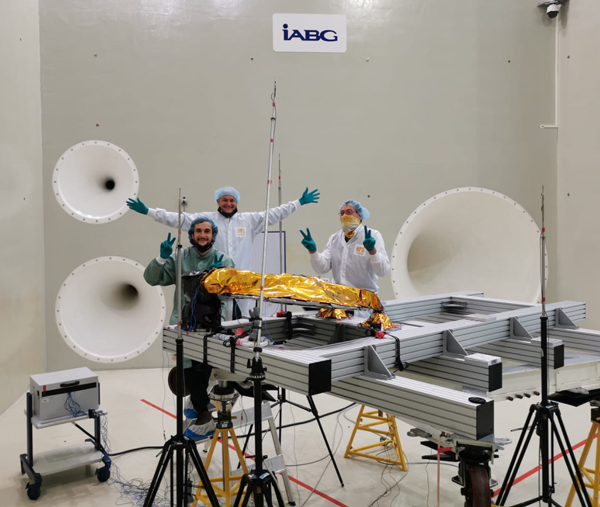
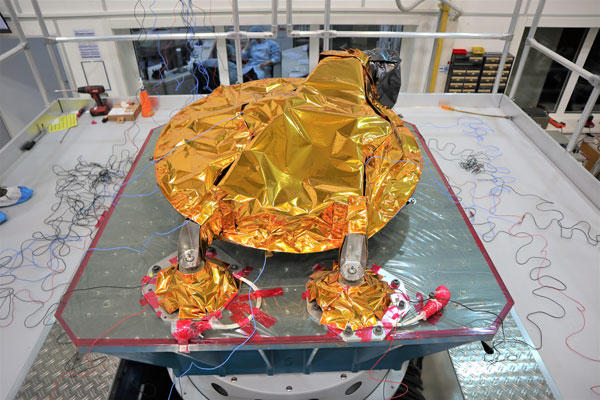
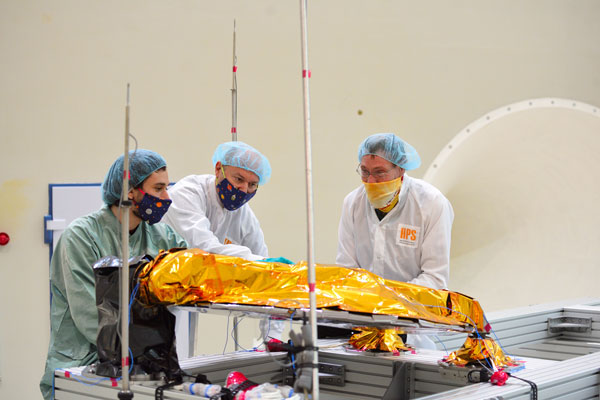
Quad successful premiere for Europe’s non-dependence in space
Noveber 2020
Deployable 5-meter “LEA” antenna starts baptism of fire on the test stand
Punctually three years after the decision of the EU, in November 2017, to place the development of the critical space technology of an antenna that can be deployed in space in the hands of an SME-consortium with 15 companies from seven member states led by the Munich-based antenna specialist HPS, the project celebrated four successful European premieres on November 10th 2020:
- Installation of a 5m deployable reflector of and by LSS GmbH
- First surface accuracy check of this reflector
- First RF (Radio-Frequency) test of the complete reflector
- First successful application of highly innovative RF-test technology.
The space programs of ESA and the EU reflect the enormous importance of research and application projects from earth observation and telecommunications for the development of independent ecological and economic positions in politics and business.
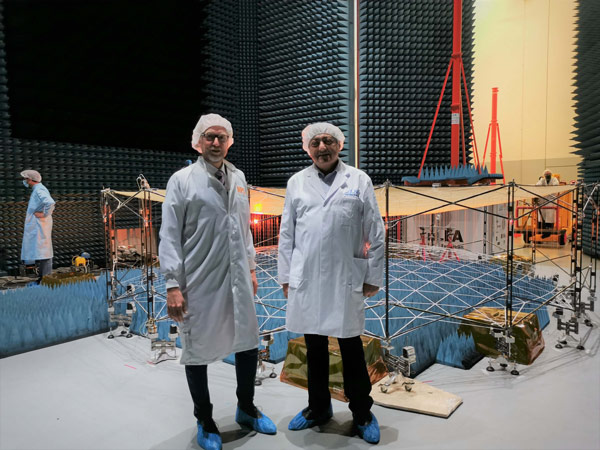
The first prerequisite for this is the unrestricted availability of the communication capabilities and image data collection of corresponding satellites – and thus of their antennas. In order to save weight and storage, more and more deployable constructions are being planned here, which have so far only been available in the USA. Europe has now put a stop to this dependence.
The 5-meter antenna (now under test) under the designation “LEA-X5”, is intended for X-band communication. The surface accuracy of the reflector, developed since the beginning and assembled now by LSS for many months, was measured by HPS with laser radar technology from NIKON. The element of the antenna responsible for the reflection, the gold plated metal mesh under the designation “ESM-European Space MESH”, is also compatible with the higher Ku-band. It is manufactured by HPTEX, a joint venture of HPS and Iprotex in cooperation with Fraunhofer in Münchberg. The high-precision carbon fiber struts were developed by the Portuguese company “FHP”, while unfolding electronics were supplied by the Schwetzingen Company “von Hoerner & Sulger”.
Also the adherence to all interlinked corridors of the participants all over Europe to realize this early test date was successful despite considerable organizational complications caused by the Covid-19 pandemic: “operative flexibility in teamworking, technical genius and the unconditional will to succeed – these are the decisive factors especially in these times. And the WeLEA example shows once again: These are medium-sized companies,” says HPS CEO Pfeiffer. And the CEO of LSS, Leri Datashvili adds: “it has been a very hard work of the LSS team after having collected all the needed components and materials from partners to have designed and built a 5 m large deployable reflector in a very short time reaching the high quality of the RF surface shape, which is now ready for the RF tests”
Now the reflector will be characterized in several frequency ranges (C to Ka-Band) from Airbus over the next 3 weeks in Ottobrunn. Special ground support mechanisms from the Portuguese company INEGI ensure that the reflector is positioned horizontally. The prediction of the antenna performance was carried out by the Danish company TICRA with the help of their special RF software GRASP, with geometrical data from LSS simulations.
In the next step, not only the reflector, also the deployable arm of the antenna will be tested environmentally at INTA in Spain; the focus will be on compliance with vibration, shock and thermal vacuum requirements. Beginning next year intensive deployment tests will follow finally. The entire test campaign will be concluded with PFM (proto-flight model) status in March 2021.
In parallel, WeLEA is already working on an 8-meter Ka-band capable engineering model “LEA-K8r” (reflector and arm) in contract to ESA, as preparation for the technical realization of the polar cap mission CIMR (Copernicus Imaging Microwave Radiometer), which will help Europe to gain its own and politically unbiased picture of the status of climate change. The first deployment tests are planned here for the first quarter 2021.
About WeLEA:
The European SME dominated „WeLEA“-SME-consortium consists of the following European space companies: HPS (prime contractor, DE), LSS (main partner for the reflector, DE), RUAG (DE), FHP (PT), vH&S (DE), Luma (SE), Invent (DE), HPtex (DE), ARQUIMEA (SP), etamax (DE), TICRA (DK), WSS (DE), Inegi (PT), INTA (SP), ONERA (FR). The consortium is strengthened in the H2020-LEA-X5 project on system- and test-side by OHB (DE), TAS (FR) and Airbus (DE).
Igniting the Upper Stage on Europe’s path to technological non-dependence
December 2020
ESA and Thales Alenia Space Italy (TAS-I) authorize HPS to develop the large deployable reflector subsystem “LEA” for the Copernicus mission CIMR
It is official today, 02.12.2020: Europe is going to develop a new independent technology in the European space sector. Thales Alenia Space Italy has been selected by ESA and the European Commission as the Satellite Prime for the Copernicus mission CIMR contract. At the same time, HPS Germany, as leader of an SME-oriented consortium of 15 companies from seven countries (main partners are LSS, vonHoerner&Sulger and RUAG), were selected to develop the “Large Deployable Reflector Subsystem” (LDRS) called “LEA-K8r”. This large, 8-meter diameter reflector will be deployed in space and rotates about a non-symmetrical axis: a world first! Today, with this contract signature, HPS and the European consortium have been authorized to start the development with the phases B2/C/D.
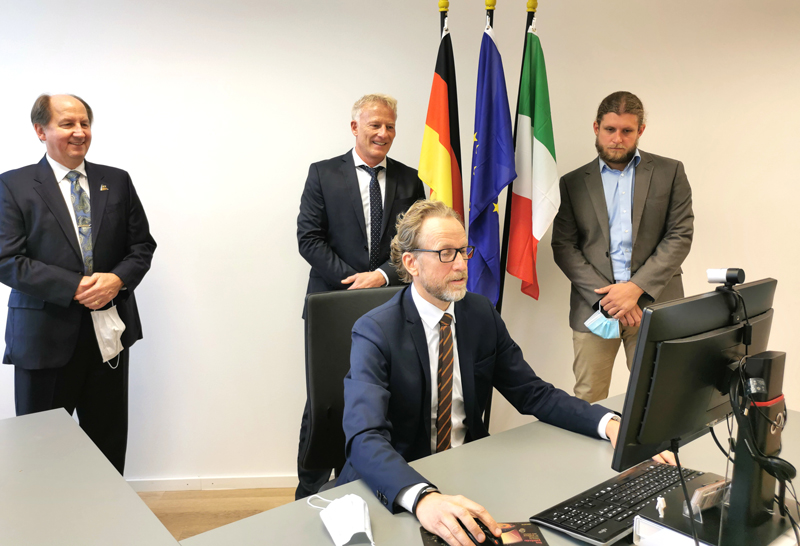
The CIMR-mission, in the context of the Copernicus Earth Observation Programs of the European Commission, provides a significant contribution to the „Integrated European Policy for the Arctic“, whose objective is an improved understanding of the effects of climate change, especially in the Arctic region, and thus will establish key requirements for the Arctic communities. The CIMR-mission will provide improved continuity (sub-daily) in the monitoring of floating sea ice in terms of spatial and temporal resolution. In addition, the instruments will provide global coverage of sea surface temperature measurements, but with a specific focus on the Polar Regions.
Authorized was now the first tranche with 23.0 MioEuro for Phase B2, with an HPS-share of 7.1 MioEuro for two years. In total, the Phase B2/C/D/FM2 contract amounts to 110 Mio Euro until the PFM Satellite launches in 2027 and until the delivery of the FM2 LEA-reflector-subsystems in 2028. The share of HPS Germany values to 26 Mio Euro, which results in an average of 3.2 MioEuro per year, and which assures 15-20 high quality jobs.
HPS CEO Ernst K. Pfeiffer commented: “We are all very pleased to be able to make an active contribution to European non-dependence in an area of critical technology as a subcontractor to TAS-I, and to be able to assume global technology leadership with the innovation of an unprecedented rotating 8m Ka-band reflector subsystem in our portfolio. On behalf of the WeLEA-consortium, I would like to thank all those in Germany and throughout Europe who have supported our ten-year journey to this strategically, politically and technically magnificent position.”
The first phase, B2, includes the detailed design of an EQM. Central to this effort is an intensive breadboard test program, which will raise the few remaining critical elements of LEA to Technology Readiness Level (TRL) 5 within 6 months. As an example, a Ka-band mesh, the “European Space Mesh”, is being developed and produced by the new HPS/IPROTEX joint-venture “HPTEX” along with cooperation from Frauenhofer ISC, in Upper Franconia. Since this metal mesh needs to have an optimal design with respect to electromagnetic wave reflection and mechanical stretch parameters, intensive parameter studies are currently being undertaken. Promising initial results have already been achieved in pre-development.
And our next goals are already in sight: Hydroterra, ESA’s EE10 Candidate Mission which requires a deployable reflector of at least 7 meters in diameter; SENTINEL-1 NG Mission, requiring a single large reflector; and a Ka-Band Internet Broadband mission with 5-metre reflectors.
In addition to large deployable reflector subsystems, the main product lines of the HPS portfolio are classic 1-2 meter reflector antennas for science missions (e.g. Euclid & HERA) and telecommunication missions (e.g. Heinrich Hertz), as well as the world’s only operational product series of serially-manufactured satellite-de-orbit systems under the brand name “ADEO” for decommissioned satellites. By the end of 2021, the HPS Group, consisting of HPS Germany, HPS Romania and HPtex, will grow at least up to 100 employees.
HERA: High Noon in Deep Space
December 2020
… and the world watches via an HPS antenna!
As is well known, the ESA Council of Ministers Conference 2019 has brought a major “jolt” to the German space industry – which German President Herzog had called for as early as 1997 – and a “jolt” that will travel around the world as the moon landing once did! With HERA, Europe is participating in the development of the first Earth defence mission against asteroid aggressors from space. USA is preparing the second satellite. And just like the moon landing more than half a century ago, this project will capture the attention of people all over the world with its images! HERA will transmit these images from well over ten million miles away starting in 2027. Just before Christmas 2020 TAS-ES/OHB contracted HPS now for Phase 1 of the antenna development.
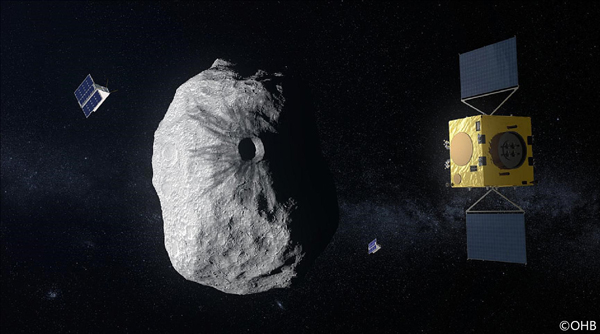
A central element of the HERA satellite is the X-Band antenna subsystem from the German antenna specialist, HPS (Munich). A complete 1.2-meter diameter antenna will be made of highly stable Carbon Fibre, with an extremely low weight, high Eigenfrequency, and good reflectivity. For HPS, the experience gained from its major antenna projects, such as Euclid (ESA, direct customer TAS-SP) and Heinrich-Hertz (DLR, direct customers TESAT/OHB), has created a well-known and proven technology background. This is a major advantage for a mission whose launch date is unalterably fixed in 2024, leaving only 22 months from Kick-off until the required delivery date of the antenna in October 2022.
On 15.09.2020, ESA signed the HERA satellite Prime Contract with OHB-Bremen.
For this mission, Thales Alenia Space Spain (TAS-SP) is responsible for the entire Communication Subsystem and will be the direct customer for HPS GmbH. HPS will utilize INVENT (Braunschweig) as its main subcontractor for the “Build-to-Print” production of the Main Reflector Dish. HPS´s subsidiary in Romania will support with engineering services and hardware components, e.g., the Secondary Reflector.
On 16.12.2020, HPS received their official “GO!” from TAS-SP for PHASE1. For several months now, the project team has been working on the design in order to safeguard the project schedule.
HPS CEO, Ernst K. Pfeiffer, commented: “We are delighted and honoured by our participation in this historic mission. We are pleased to contribute, not only with our established expertise as antenna specialists, but also with the passion of SMEs, being willing to start immediately with a very highly-motivated team. We will be on time! It is exciting to be part of a process of turning science fiction into a technological reality for the benefit of all mankind. My employees are fired up for this mission, and we are investing our own resources, because HERA will also support HPS’s long-term expansion plans.

